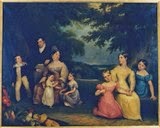http://blog.library.leeds.ac.uk/blog/special-collections
My manager edited it here and there but the general info is there. She then, unexpectedly, sent an e-mail telling everybody that it had been posted. I felt quite awkward about this at first, but then had four people either send me a message or come up to me saying they liked it, or, in the case of one of them who is a Geordie, ‘it was good like’. Another of these people was the archive manager who oversees the work of my manager and myself. It meant a lot to me that she is happy with what I've been doing. Everyone in Special Collections is so nice it's like you're living in Niceville. I can't think about anyone there without going ‘Awwww, they're so nice’. I think how lucky I am every day I'm there.
 I also think about the time my sister bought me the Mr Man book ‘Mr Quiet’ as
a joke. Mr Quiet was fed up because
everything around him was too loud – he resolved this by moving to Happyland
and working in a library! Little did I
know that this text would be eerily prophetic.
I also think about the time my sister bought me the Mr Man book ‘Mr Quiet’ as
a joke. Mr Quiet was fed up because
everything around him was too loud – he resolved this by moving to Happyland
and working in a library! Little did I
know that this text would be eerily prophetic.Oh – and they want me to write to more blog posts! One in January and another summing things up at the end of my internship.
In other news: you may remember that I've been fascinated by a black-and-white photograph of a Victorian portrait of the Pease family of Chapel Allerton.
I took a two-week free trial of the genealogy site ancestry.co.uk, which helps you build your family tree but also hosts a community of family historians who help each other out. Partly I just wanted to see how it worked, but my main intention was to look at the Pease family tree. Names were repeated over and over again in their family, so there were about five Thomas Peases and it was confusing the hell out of me. After printing out some branches of trees with the info I wanted, I sent a message to the person who'd uploaded the colour picture of the portrait, Sarah, asking her if she knew where the original was. She turned out to be a contemporary member of the Pease family (I don't know the exact relationship because Ancestry doesn't show names of people who are still living). She was quite happy to answer my query.
Apparently, the real painting is with a family member so, as I suspected, I won't be able to go and see it, but Sarah gave me some very interesting information: the picture was passed down to Thomas Pease, the young boy in the painting, but he never hung it in his house. This was all because of Jane Pease, the baby in this picture. You remember I mentioned her before as having been in and out of institutions, although I did go back and change that post, because it seems it wasn't through mental health issues but from being what Marion Pease calls ‘mentally deficient’ (so obviously a mental disability or learning difficulties). Thomas Pease was afraid that this condition could be inherited, and he was so determined not to worry his wife and children about it that he kept Jane's existence a secret from them. Sarah says that, for years Marian Pease never knew that she had an Aunt Jane. We don't know when she finally found out. As somebody interested in the medical humanities and approaches to disability, I’m really intrigued by this story. I really wish I knew what kind of life Jane Pease had. Her behaviour must have really disturbed her brother – or was it just the attitudes of the time that made him feel the way he did?
In return for helping me, I sent Sarah a list of the portraits we have at the Brotherton so she could see if there were any she could add to the images in her family tree. There is one she wants, and actually it’s one that I’m hopefully going to digitise after Christmas, so if it ends up going online, she’ll be able to see it. Maybe, once it’s available to the public, I’ll be able to take a photo of it if she can’t use the image on the screen (or come to Leeds to see it herself!). This has all brought home to me how important family archives are – we are dealing in real people’s lives. Although we’re not a local history archive as such, this is an example of how today’s generations can use the Brotherton’s collections to get a true sense of what life was like for their remarkable ancestors.











